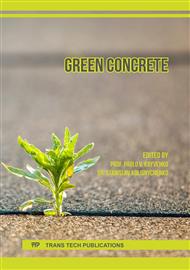[1]
O. A. Mohamed, O. F. Najm, Splitting Tensile Strength of Self-Consolidating Concrete Containing Slag, Proceedings: Toronto'2016 AES-ATEMA International Conference Advanced and Trends in Engineering Materials and their Applications, (2016).
Google Scholar
[2]
ACI-233R. - Ground granulated blast-furnace slag as a cementitious constituent in concrete, American Concrete Institute, Farmington Hills, Michigan, (1995).
DOI: 10.14359/1125
Google Scholar
[3]
S. Rafat, B. Rachid, Use of iron and steel industry by-product (GGBS) in cement paste and mortar. Resources, Conservation and Recycling, (2012), pp.29-34.
DOI: 10.1016/j.resconrec.2012.09.002
Google Scholar
[4]
BS-1881: 105 (1984). Testing Concrete Part 105. Method for determination of flow. British Standards Institution.
Google Scholar
[5]
BS-1881: 116 (1983). Testing concrete Part 116. Method for determination of compressive strength of concrete cubes. British Standards Institution.
Google Scholar
[6]
BS-1881: 117 (1983). Testing concrete Part 117. Method for determination of tensile splitting strength. London: British Standards Institution.
Google Scholar
[7]
A. F. Bingol, I. Tohumcu, Effects of different curing regimes on the compressive strength properties of self-compacting concrete incorporating fly ash and silica fume, Mater. Des. 51 (2013) 12–18.
DOI: 10.1016/j.matdes.2013.03.106
Google Scholar
[8]
M. A. Mansur, M. M. Islam, Interpretation of concrete strength for nonstandard specimens. J. Mater. Civil Eng. 14(2) (2002) 151-155.
DOI: 10.1061/(asce)0899-1561(2002)14:2(151)
Google Scholar
[9]
O. Boukendakdi, S. Kenai, E. H. Kadri, F. Rouis, Effect of slag on the rheology of fresh self-compacted concrete. Constr. Build. Mater. 23 (2009) 2593–2598.
DOI: 10.1016/j.conbuildmat.2009.02.029
Google Scholar
[10]
N. Arioglu, Z. C. Girgin, E. Arioglu Evaluation of ratio between splitting tensile strength and compressive strength for concretes up to 120 MPa and its application in strength criterion. ACI Mater. J. 103 (2006) 18-24.
DOI: 10.14359/15123
Google Scholar
[11]
O. A. Mohamed, Z. I. Syed, O. F. Najm, Splitting tensile strength of sustainable self-consolidating concrete. International Conference on Sustainable Design, Engineering and Construction 145 (2016) 1218-1225.
DOI: 10.1016/j.proeng.2016.04.157
Google Scholar
[12]
J. Kishan, To effect on strength properties of concrete of by using GGBS by Partial Replacing cement and addition of GGBS without replacing cement, SSRG Int. J. Civil Eng. 3 (2016) 144-149.
DOI: 10.21275/v5i2.25021601
Google Scholar



